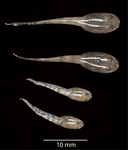|
Limnonectes larvaepartus Iskandar, Evans & McGuire, 2014
| family: Dicroglossidae subfamily: Dicroglossinae genus: Limnonectes |
| Species Description: Iskandar DT, Evans BJ, McGuire JA. 2014. A novel reproductive mode in frogs: a new species of fanged frog with internal fertilization and birth of tadpoles. PLoS One (DOI:10.1371/journal.pone.0115884) | |
 © 2015 Jimmy McGuire (1 of 4) |
|
|
|
Description Besides being the only species of frog in the entire world known to give birth to live tadpoles, it differs from other Sulawesi Limnonectes species in many ways: L. microtympanum and L. arathoonii occur in the Southwestern Peninsula of Sulawesi Island away from the range of L. larvaepartus; L. microtympanum is much larger than L. larvaepartus with relatively smaller tympana; L. arathoonii has less webbing, melanic spots above the forelimbs, a ridge coming from running down the back each eye, and no grainy tubercles on the back; L. modestus has a darkish throat with more solid dark coloration running down to the chest region than L. larvaepartus, and more extensive grainy tubercles (Iskandar et al. 2014). Live specimens tend to have a brown-grey back, with a light yellow vent region. The tympana are typically black. There is a light stripe in the area between the eyes, and this region down to the snout is lighter in color than the rest of the back. The upper half of the iris is gold-orange in at least some of the individuals. The throat of males is darker and may also have a noticeably dark, spotted, crescent shape. The upper tibia usually has a dark spot (Iskandar et al. 2014). Most of the variation comes from coloration. Though most individuals have a brown-grey back, others may have a red-brown or gold-tan back. The sides of the back are sometimes darker than the rest of the back (Iskandar et al. 2014). Distribution and Habitat Country distribution from AmphibiaWeb's database: Indonesia
Life History, Abundance, Activity, and Special Behaviors Fertilization is internal, though it is unknown exactly how they reproduce. Adult males tend to call in small bodies of water away from streams. Many of these bodies of water have tadpoles in them. The amount of time males spend in proximity to these tadpoles is possible evidence of parental care. In some instances, adults have been found in bodies of water with different sizes of tadpoles, which suggest that both males and females are territorial and may visit the same body of water multiple times to reproduce (Iskandar et al. 2014). Larva Tadpoles discovered internally in the enlarged oviducts are slender and tiny, packed in both oviducts. They mostly clear in color with spots around their bodies (Iskandar et al. 2014). In one female, 46 tadpoles (at stage 25) were found in the left oviduct and 50 in the right oviduct; total clutch size was 103 as 7 more were ejected when she was caught. The tadpoles ranged from 13.4−14.0 mm in total length. The labial tooth row formula (LTRF) was 1/2 at stage 25 (Kusrini et al. 2015). Free-swimming tadpoles found in ponds and small water bodies were at Gosner stages 25−37. They have a sinistral spiracle about midway between the eye and vent, which opens posterodorsally with a definite medial wall. The vent tube is dextral and has a large bore widening distally. The oral disc is oriented ventrally, and the labial tooth row formula is 2(2)/3 with a wide gap in the second upper row; it has large labial teeth which are spaced apart. The body coloration is mottled with melanophores but are absent on the spiracle. The ventrum is clear and transparent making the intestine and some of the jaw muscles visible. The eyes are placed dorsally. Tail and fins are also marked with small dark patches on a pale background; the tail bears faint indistinct bands (much less so than other species of Limnonectes (Kusrini et al. 2015). Trends and Threats Relation to Humans Comments Limnonectes larvaepartus descended from earlier Limnonectes species that colonized Sulawesi and then radiated throughout the island (Iskandar et al. 2014). As of March 2015 this is this only species of frog known, other than frogs in the genera Nectophrynoides and Nimbaphrynoides, and the possibly extinct Eleutherodactylus jasperi, to give birth to live young, though all these other species give birth to froglets instead of tadpoles (Iskandar et al. 2014). This species was featured in PLoSable (February 2015), a science website for teens run by the Public Library of Science (PLOS).
References
Iskandar, D.T., Evans, B.J., McGuire, J.A. (2014). ''A novel reproductive mode in frogs: a new species of Fanged Frog with internal fertilization and birth of tadpoles.'' PLoS ONE, 9(12), e115884. Kusrini, M.D., Rowley, J.J.L., Khairunnisa, L.R., Shea, G.M., Altig, R. (2015). ''The Reproductive Biology and Larvae of the First Tadpole-Bearing Frog, Limnonectes larvaepartus.'' PLoS ONE, 10(1), e116154. Originally submitted by: Gordon Lau (first posted 2015-05-18) Life history by: Michelle S. Koo (updated 2022-08-19)
Larva by: Michelle S. Koo (updated 2022-08-19)
Edited by: Michelle S. Koo (2022-08-19) Species Account Citation: AmphibiaWeb 2022 Limnonectes larvaepartus <https://amphibiaweb.org/species/8292> University of California, Berkeley, CA, USA. Accessed May 16, 2025.
Feedback or comments about this page.
Citation: AmphibiaWeb. 2025. <https://amphibiaweb.org> University of California, Berkeley, CA, USA. Accessed 16 May 2025. AmphibiaWeb's policy on data use. |


 Map of Life
Map of Life